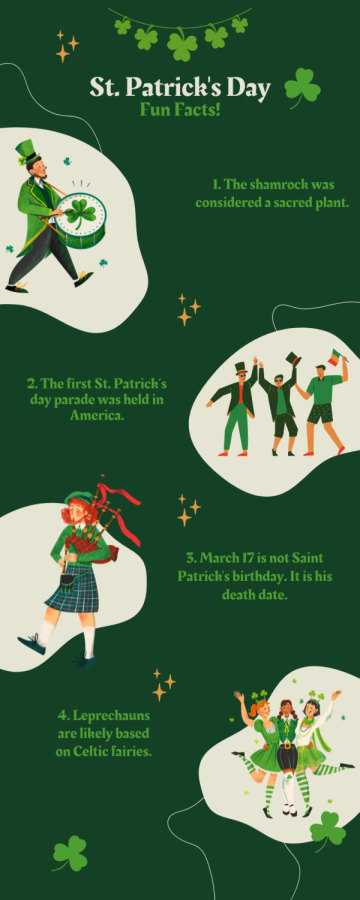What is St. Patrick’s Day really about?
St. Patrick’s Day! It’s a time to be cheery, wear green, and catch leprechauns! But most people don’t actually know what St. Patrick’s Day is about. Did you know that St. Patrick wasn’t born in Ireland? Let’s take a look at why we celebrate St. Patrick’s Day.
According to the History Channel, St. Patrick lived during the fifth century. St. Patrick grew up in England, and at the time, he wasn’t a saint yet. He was a naughty boy. Then one day Ireland attacked. His father told Patrick to stay with the family and protect them. Patrick didn’t listen. He went out to fight and became captured. That night he prayed to God for the first time. He asked God to help him and told God that he was scared and didn’t know what to do.
As the weeks went by, an answer came, but it wasn’t the obvious one. His master woke him up one day saying he had a special job for Patrick. Patrick’s master told him he wanted him to take his flock of sheep to the hills. He didn’t try to escape. In fact, he was a shepherd for six years. Being a shepherd gave him a lot of time alone. After a while, he began to experience dreams and visions. He heard a voice saying he would return to his own country again. In one dream he saw a majestic sailing ship and heard someone say, “Your ship is ready.” Because of his dream, the next time Patrick took the flock back to the farm, he decided to talk with his master. He asked for his freedom. His master said no. That night, Patrick ran away.
According to the History Channel, “Patrick walked nearly 200 miles from County Mayo, where it is believed he was held, to the Irish coast. After escaping to Britain, Patrick reported that he experienced a second revelation—an angel in a dream tells him to return to Ireland as a missionary.” Soon after, Patrick began religious training, a course of study that lasted more than 15 years. After becoming a priest, he was sent to Ireland with a two-part mission: to convert the Irish to Christianity and to teach the ones who already lived there.
Now you know who St. Patrick was, a man, captured, ran away, and brought Christianity to Ireland. But why is green associated with St. Patrick’s Day? According to the History Channel, one of the reasons we wear green on St. Patrick’s Day is because of Ireland’s nickname, The Emerald Isle. The green stripe in the Irish flag also played a role. The Irish countryside may be many shades of green, but knights in the Order of St. Patrick wore a color known as St. Patrick’s blue. Why did green become so emblematic of St. Patrick that people began drinking green beer, wearing green, and of course, dyeing the Chicago River green to mark the holiday he inspired? The association probably dates back to the 18th century, when supporters of Irish independence used the color to represent their cause.
Some say that St. Patrick banished the snakes from the Emerald Isle. Legend has it that Patrick stood on an Irish hillside and delivered a sermon that drove the island’s serpents into the sea. While it’s true that Ireland is snake-free, chances are that’s been the case throughout human history. Water has surrounded Ireland since the end of the last ice age, preventing snakes from slithering over. Before that, it was blanketed in ice and too chilly for cold-blooded creatures. Scholars believe the snake story is an allegory for St. Patrick’s eradication of pagan ideology. In conclusion, St. Patrick’s day is a fun day to celebrate for all.

Hi, my name is Lincoln Murphy and I am in sixth grade. I am a writer for the Bulldog Barker school newspaper. This is my second year on the Bulldog Barker...





